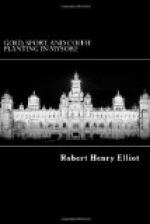There was a very good crop on the trees when I passed through Coorg—one that, when picked, quite exceeded the expectations of the planters—and I saw two estates which had at once a good crop on the trees, leaves of good, well-fed looking colour, and a show of wood giving promise of an equally good crop for the following year; and it says well for cultivation in Coorg that any estate could show this, for the tendency of coffee, as of most fruit trees, is to give heavy and light crops alternately. As it is important to know the manures that were used to produce such results, I may mention that on one of these estates 6 cwt. of castor cake and 3 cwt. of bones had been applied the previous year, and for the four preceding years 2 cwt. of castor cake and 1 cwt. of bone had been used, but, in the opinion of the manager, the latter application had proved too small. On the other estate one-third of a bushel of cattle manure per tree, and from 7 cwt. to 10 cwt. of bones had been applied once in three years, and composts also had been used to a considerable extent. These were formed first of a layer of vegetable rubbish, then fresh pulp and lime, and lastly a layer of soil. The estate last referred to, on which the cattle manure, bones and compost had been used, belongs to Mr. Mangles—his Coovercolley estate—and is certainly the finest I ever saw, if we take into consideration the state of the soil, the colour of the foliage, and the evident prospect of continuously good crops. So well fed, indeed, was the land with nitrogen, that an application of nitrate of soda produced no perceptible effect on the trees. The land was probably over supplied with phosphoric acid, and an analysis of the soil would be of practical value, for if, as I have good reason to surmise, there is a very large supply of phosphoric acid in the soil, the use of bones might be suspended for some years, and a light application of lime used instead. Ten acres, at any rate, might be tried as an experiment. I was shown one piece of coffee which had been manured, when it was two years old, with cattle manure, and this piece had remained perceptibly superior ever since. On this estate 600 cattle are kept for the sake of their manure. I would suggest that the proprietor might, on say ten acres, discontinue the use of cattle manure, and, as an experiment, apply dressings of jungle top-soil instead, or the red earth alluded to in my chapter on manures, should that be available. The experiment might be valuable to the proprietor and to planters in general. Cattle manure is very expensive, and when 12 to 14 tons per acre—some fairly well rotted and some slightly so—were used in Coorg on one estate the cost was 72 rupees an acre, including cost of application.




